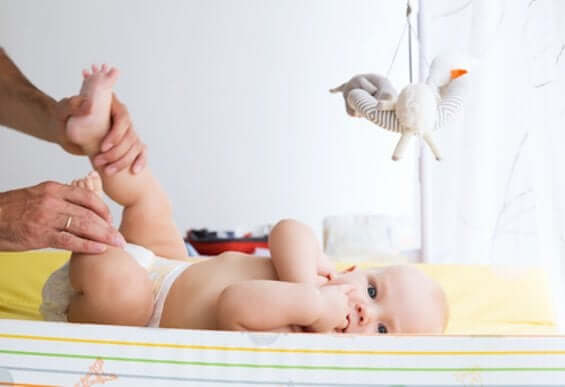7 Curiosities About Body Language in Babies

Body language in babies is the intuitive way in which they express their needs and emotions even from their first days of life. Before developing the ability to articulate phonemes and words, children can communicate by nonverbal means.
Their movements and sounds are signs of their desire to express themselves and their innate tendency towards interaction and attention.
“From the time children are in their mother’s womb, they require important stimulation which somehow benefit their growth and development, however it’s important to know that when they are born, they need special care that contributes to a better quality of life.”
– Manual for Proper Stimulation – University of Antioch –
Each gesture that a little one makes has a meaning and requires a response from his or her parents. When you learn to interpret the movements of babies, then you’ll be able to comprehend their feelings and mood changes.
That’s why we want to talk about the communicative signs that children tend to emit and the emotions that may be associated with them. Below you’ll find 7 different nonverbal manifestations that babies often present as well as what each one may indicate.
What body language in babies means
1. Energetically moving their legs
This gesture tends to have a very positive connotation. In most cases, when babies energetically kick their legs, it’s a sign that they’re having fun and are very happy.
Therefore, you’ll notice these movements when you play with your baby and give your little one a warm bubble bath, etc. If you want to see this happiness become even greater, sing a song or respond by clapping and cheering your baby on.
2. Arching their backs with determined movements
When babies arch their backs and are unable to calm down, these are reactions to physical pain or discomfort. This movement may indicate that your baby needs to change to another position. It may also be an indication of gastric discomfort, such as stomach acid.
In this case, you should help your baby find a more comfortable position, especially if you’re feeding him or her. If the behavior persists, you should consult a pediatrician to rule out gastroesophageal reflux disease (GERD).

3. Tense arms and clenched fists
Just as with adults, when children clench their fists tightly, it’s a sign of anger or stress. During the first months of life, this reaction may be a sign that a child is hungry or in need of a diaper change. Your baby may or may not cry while making this gesture. Either way, it’s important that you give him or her your immediate attention.
4. Rubbing their eyes
This endearing gesture, especially when it’s accompanied by yawning or tears, is usually an indication that your baby is tired. Try to calm your little one and sing a lullaby until he or she finally falls asleep. No doubt your baby will feel better after a good nap. If this doesn’t work and the eye rubbing persists, you should see your pediatrician to rule out an eye infection.
5. Sucking on hands or fists
Most of the time, when babies suck on their hands or fists, it means they’re hungry. If you feed your baby and come to the conclusion that hunger isn’t the issue, then it may just be your baby’s way of falling asleep.
Many babies put their hands in their mouths before taking a nap as a way to calm down. In that case, there’s nothing you need to do except let them rest.
6. Startled movements
It’s common for babies to make sudden startled movements with their bodies, especially when they’re sleeping. It’s nothing you need to work about. In fact, it’s a common reflex during the first six months of life.
These sudden reactions may occur because of some noise or abrupt action that occurs and startles your baby. To avoid them, you can keep sounds and movements to a minimum when your little one is snoozing.
7. Bending their knees towards their bodies
When babies repeatedly curl up their bodies by bringing their knees up to their bellies, they may have indigestion. The most common digestive issues that little ones experience are abnormal intestinal movements, the accumulation of gases, or constipation.
If you’re breastfeeding, then avoid consuming irritants so that your baby’s gastric function goes back to normal. If the problem doesn’t go away soon, then you should ask for recommendations from your little one’s pediatrician.

Conclusions
Once you understand what body language in babies means, you can start to relax. When you know what your baby’s gestures and sounds mean, you’ll be better able to respond to your child’s needs and wants.
Until your baby develops the ability to articulate words, you need to learn to read his or her nonverbal signals. Every day, parents can understand their child’s actions and messages better and better, even though they can’t speak.
Body language in babies is the intuitive way in which they express their needs and emotions even from their first days of life. Before developing the ability to articulate phonemes and words, children can communicate by nonverbal means.
Their movements and sounds are signs of their desire to express themselves and their innate tendency towards interaction and attention.
“From the time children are in their mother’s womb, they require important stimulation which somehow benefit their growth and development, however it’s important to know that when they are born, they need special care that contributes to a better quality of life.”
– Manual for Proper Stimulation – University of Antioch –
Each gesture that a little one makes has a meaning and requires a response from his or her parents. When you learn to interpret the movements of babies, then you’ll be able to comprehend their feelings and mood changes.
That’s why we want to talk about the communicative signs that children tend to emit and the emotions that may be associated with them. Below you’ll find 7 different nonverbal manifestations that babies often present as well as what each one may indicate.
What body language in babies means
1. Energetically moving their legs
This gesture tends to have a very positive connotation. In most cases, when babies energetically kick their legs, it’s a sign that they’re having fun and are very happy.
Therefore, you’ll notice these movements when you play with your baby and give your little one a warm bubble bath, etc. If you want to see this happiness become even greater, sing a song or respond by clapping and cheering your baby on.
2. Arching their backs with determined movements
When babies arch their backs and are unable to calm down, these are reactions to physical pain or discomfort. This movement may indicate that your baby needs to change to another position. It may also be an indication of gastric discomfort, such as stomach acid.
In this case, you should help your baby find a more comfortable position, especially if you’re feeding him or her. If the behavior persists, you should consult a pediatrician to rule out gastroesophageal reflux disease (GERD).

3. Tense arms and clenched fists
Just as with adults, when children clench their fists tightly, it’s a sign of anger or stress. During the first months of life, this reaction may be a sign that a child is hungry or in need of a diaper change. Your baby may or may not cry while making this gesture. Either way, it’s important that you give him or her your immediate attention.
4. Rubbing their eyes
This endearing gesture, especially when it’s accompanied by yawning or tears, is usually an indication that your baby is tired. Try to calm your little one and sing a lullaby until he or she finally falls asleep. No doubt your baby will feel better after a good nap. If this doesn’t work and the eye rubbing persists, you should see your pediatrician to rule out an eye infection.
5. Sucking on hands or fists
Most of the time, when babies suck on their hands or fists, it means they’re hungry. If you feed your baby and come to the conclusion that hunger isn’t the issue, then it may just be your baby’s way of falling asleep.
Many babies put their hands in their mouths before taking a nap as a way to calm down. In that case, there’s nothing you need to do except let them rest.
6. Startled movements
It’s common for babies to make sudden startled movements with their bodies, especially when they’re sleeping. It’s nothing you need to work about. In fact, it’s a common reflex during the first six months of life.
These sudden reactions may occur because of some noise or abrupt action that occurs and startles your baby. To avoid them, you can keep sounds and movements to a minimum when your little one is snoozing.
7. Bending their knees towards their bodies
When babies repeatedly curl up their bodies by bringing their knees up to their bellies, they may have indigestion. The most common digestive issues that little ones experience are abnormal intestinal movements, the accumulation of gases, or constipation.
If you’re breastfeeding, then avoid consuming irritants so that your baby’s gastric function goes back to normal. If the problem doesn’t go away soon, then you should ask for recommendations from your little one’s pediatrician.

Conclusions
Once you understand what body language in babies means, you can start to relax. When you know what your baby’s gestures and sounds mean, you’ll be better able to respond to your child’s needs and wants.
Until your baby develops the ability to articulate words, you need to learn to read his or her nonverbal signals. Every day, parents can understand their child’s actions and messages better and better, even though they can’t speak.
All cited sources were thoroughly reviewed by our team to ensure their quality, reliability, currency, and validity. The bibliography of this article was considered reliable and of academic or scientific accuracy.
- Sandri, R. (2000) Les bébés pas encore nés (à l’écoute des parties embryonnaires de la personnalité). V Coloquio Internacional de Observación de Bebés,Esther Bick. Río de Janeiro, 2.000.
This text is provided for informational purposes only and does not replace consultation with a professional. If in doubt, consult your specialist.








